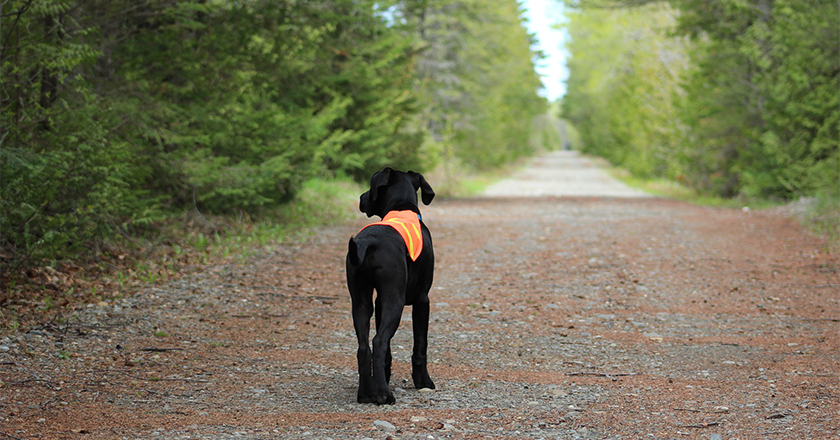This post was updated in June 2022 to include tips for extreme weather conditions.
We all love our furry friends, but it can be easy to overlook their safety in times of crisis. Sometimes we aren’t even prepared ourselves, let alone prepared for our pets. Fortunately, there are some basic steps you can follow to ensure your pet’s safety during an emergency.
Be Prepared
You may have read Veoci’s previous blog about building an emergency preparedness kit, but you might be surprised to learn that you can create a preparedness kit for your pet as well. When a natural disaster strikes, having emergency kits already prepared helps you and your family make a quick exit, or provides you with the necessary supplies to bunker down at home.
Here are some items, according to Trupanion, that you will want to pack for your pet in their emergency preparedness kit:
- Food and water – You want to have enough of your pet’s current food and clean water to last at least a few days
- Collar, leash, and ID – Pack extras of all of these items to ensure you are able to leash and identify your animals no matter where you’re headed
- Medicine – Make sure you have at least a few days worth of any medications your pet is on; it’s a good idea to constantly cycle these medications out of the kit to ensure they aren’t expired in the event of an emergency
- Important documents – Include copies of your pet’s license, registration, and any important medical documents; pack pictures of your pet in case you get separated
- Toys and comfort items – Emergencies can be anxiety inducing for pets as well; make sure you pack some of their favorite things, such as toys, blankets, and treats to help ease the stress of the incident
Preparation is key when it comes to staying safe! Setting these essentials aside in case an emergency arises will help keep your pet safe in times of crisis.
Travelling Safely With Your Pet
Sometimes during a disaster it is no longer safe to stay in your home. The Red Cross reminds us that “If it’s not safe for you to stay in your home during an emergency, it’s not safe for [your pets] either!” Therefore, times of crisis sometimes call for travelling to safety with your pets.
When you leave your home, make sure you bring your pet’s emergency preparedness kit with you so you have all the necessary items for your animal. Microchip your pet for convenient tracking and make sure your pet always has an ID collar on with your updated contact information.
You should invest in a travel crate to transport your animal, as well. The crate should be large enough to allow your animal to stand in it as well as turn around comfortably. Line it with an absorbent material in case your pet has an accident. It’s also a good idea to put your name, contact information, and a picture of your pet on the outside of the crate in case of separation (Veoci can make a pet reunification system that you should ask your municipality to implement!). You should also practice evacuation drills with your pet so they’re comfortable within their carriers.
If you have some warning that a natural disaster is approaching, give your pet time to acclimate to their crate and to the car by taking them on short local drives. This helps minimize anxiety during the actual incident.
As we know, cars can quickly become dangerous in severe weather. Never leave your pet alone in a parked car because heat or cold can be magnified inside the vehicle and lead to disastrous effects.
If you’re travelling on an airplane, try to book a direct flight to avoid your pet sitting out on the exposed tarmac. You might also want to tape a bag of food outside your pet’s cage so attendants can feed him/her. Another good tip is to freeze a bowl of water to put in the travel crate; your dog will be thirsty by the time it melts.
As you’re travelling to safety, your destination should be a key point on your mind. However, with an animal in tow, finding a destination is no longer straightforward. Check hotels/motels and shelters in your area to see if they allow pets. Also, it’s important to note that some shelters will be solely for animals or will confine animals to another area of the building.
Because your pet will likely come in contact with many other animals once you reach your destination, make sure their vaccinations are up-to-date and that their vaccination paperwork is in your emergency preparedness kit in case the shelter requests it.
Just in Case – Pet First Aid Tips
Although we don’t want to think about a situation in which we would have to administer first aid to our pets, it’s important to be prepared in case of emergency. Trupanion identifies essential items to include in your pet’s first aid kit, many of which would also come in handy for human first aid. This first aid kit is an excellent item to add to your pet emergency preparedness kit.
Pet first aid is fairly intuitive and quite similar to the first aid you would administer on humans. Before beginning any form of first aid on your dog, it is important to fashion a muzzle for them out of gauze, as many dogs are prone to biting when they feel pain.
Other tips include stopping bleeding with firm pressure, fashioning makeshift stretchers to transport your pet in the instance of broken bones, and seeking professional attention as soon as possible.
You might also have to give your pet the Heimlich if they’re choking or administer CPR in the event that their heart stops. There are three basics to CPR, known as CAB, which were changed from ABC in 2010 by the American Heart Association:
- Compressions
- Airway
- Breathing
To perform CPR correctly, start with compressions, as explained in the video, open the airway of your pet, then give them mouth-to-mouth. CPR can be a life-saving mechanism when performed accurately.
Pet Health During Extreme Weather
As the seasons shift, we find ourselves making changes in order to adapt to the changing climates. Our pets also have to adapt to these weather changes. When temperatures rise and fall, it’s important we prepare for these conditions not only for us, but also for our furry friends. There are precautions we can take to help take care of them while the weather is in flux. Whether it may be hot summer days in the sun or cold winter days inside, we need to be cautious about what our pets might need.
Hot Weather
When the sun is shining, it’s natural for us to want to be outside with our pets. But when the weather becomes warmer, we need to become more cautious about our pets being in the sun.
Limit Time Outside
Keep time in mind during the hot days. Try to limit walks and don’t allow them to play in the sun for too long. An easy tip is to plan your outdoor activities earlier in the day before temperatures start to rise, or in the evenings when it’s cooling down. It’s important to keep your animals hydrated and to take breaks in the shade while outside.
Heat stroke
Watch for signs of your pet possibly having a heat stroke. Symptoms of heat stroke include excessive panting, excessive drooling, high heart rate, high body temperature, vomiting, and diarrhea. If your pet is showing any of these symptoms, try to cool them down by applying a cool (not cold) wet towel to their neck and offering some water. Call a veterinarian immediately to get help. While waiting for the veterinarian, make sure to monitor their temperature.
Never Leave Pets Unattended in the Car
Do not leave your animals in the car by themselves. Even if the window is down a bit, animals should not be left in the car for a long period of time, especially in extreme weather such as hot temperatures. It will only take minutes before the temperature becomes unbearable for your pets.
Hot Pavements
Be cautious of how hot the sidewalks get as cats and dogs have sensitive paws. Hot pavement, asphalt, and artificial grass can get very hot and can burn and blister their paws. The best way to gauge if the ground is too hot is to test it with your own bare feet. A good rule of thumb is that if it’s too hot for your bare feet, it’s too hot for paws. If your pet does end up with burns or blisters, you can use antiseptic or hydrogen peroxide to help with the healing process. Another option is also to use pet shoes. These will protect their paws from both the hot pavement and the salt covered walkways in the winter.
Winter Cold Weather
When temperatures start to drop during the cold winter months, care for your pets is slightly different than the summer months.
Cold Tolerance
You don’t want to let your pets stay outside in the cold for a long period of time. Contrary to popular belief, animal fur doesn’t keep them resistant to the cold. These household animals can easily get frostbite and hypothermia. However, be mindful of grooming during winter months as their fur should not be shaved down to their skin because the extra coat will at least provide some warmth. Symptoms of hypothermia are whining, shivering, anxiousness, or sluggishness. Call a veterinarian immediately if they show any of these signs.
After Walk Care
Be sure to wipe your pets’ paws after walking on cold surfaces. Their paws could pick up on deicers, antifreeze, or other toxic chemicals laid down for ice maintenance. You can use petroleum jelly for their paws before going out to help protect them from the various chemicals. Check your pets’ paws every so often to see if they have cracked paw pads or bleeding due to the cold conditions.
Never Leave Pets Unattended in the Car
Like in summer days, pets should not be left in the car during cold winter days either. Instead of them suffering through the hot weather, now they would be suffering through the cold weather. Before traveling with your pet, make sure to heat up your car.
Home Care
Don’t wash your pets too often. They have essential oils that can be removed if they are washed often. Frequent baths increase their chances of developing dry skin. When you do give your pet a bath, be sure to use moisturizing shampoo and wash.
During the colder days, feed your pet more than they usually eat. Having the extra calories will help them stay warm, and making sure that they stay hydrated will also help with their skin from drying out from the cold air.
Wagging Tails and Safe Returns
Animals are loyal and they stick by our sides through the best and the worst of times. We should prepare ourselves to protect them in case of emergency or disaster because they are often powerless to protect themselves. With just a few basic tips, you and your furry friends can make it through any incident and come out stronger in the end.








